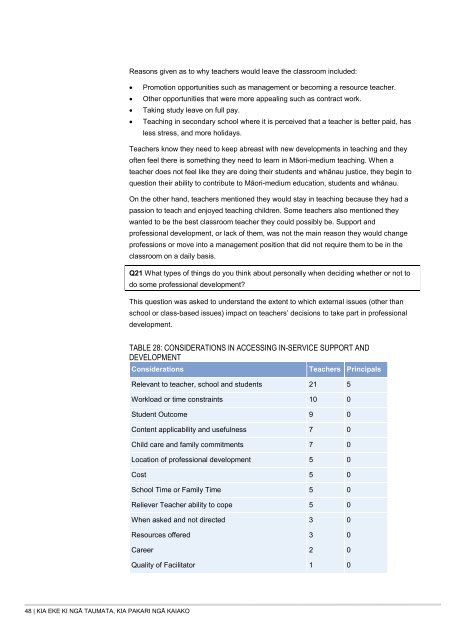Kia eke ki ngÄ Taumata, kia Pakari ngÄ Kaiako He ... - Te Puni Kokiri
Kia eke ki ngÄ Taumata, kia Pakari ngÄ Kaiako He ... - Te Puni Kokiri
Kia eke ki ngÄ Taumata, kia Pakari ngÄ Kaiako He ... - Te Puni Kokiri
Create successful ePaper yourself
Turn your PDF publications into a flip-book with our unique Google optimized e-Paper software.
Reasons given as to why teachers would leave the classroom included:• Promotion opportunities such as management or becoming a resource teacher.• Other opportunities that were more appealing such as contract work.• Ta<strong>ki</strong>ng study leave on full pay.• <strong>Te</strong>aching in secondary school where it is perceived that a teacher is better paid, hasless stress, and more holidays.<strong>Te</strong>achers know they need to keep abreast with new developments in teaching and theyoften feel there is something they need to learn in Māori-medium teaching. When ateacher does not feel like they are doing their students and whānau justice, they begin toquestion their ability to contribute to Māori-medium education, students and whānau.On the other hand, teachers mentioned they would stay in teaching because they had apassion to teach and enjoyed teaching children. Some teachers also mentioned theywanted to be the best classroom teacher they could possibly be. Support andprofessional development, or lack of them, was not the main reason they would changeprofessions or move into a management position that did not require them to be in theclassroom on a daily basis.Q21 What types of things do you think about personally when deciding whether or not todo some professional development?This question was asked to understand the extent to which external issues (other thanschool or class-based issues) impact on teachers’ decisions to take part in professionaldevelopment.TABLE 28: CONSIDERATIONS IN ACCESSING IN-SERVICE SUPPORT ANDDEVELOPMENTConsiderations<strong>Te</strong>achers PrincipalsRelevant to teacher, school and students 21 5Workload or time constraints 10 0Student Outcome 9 0Content applicability and usefulness 7 0Child care and family commitments 7 0Location of professional development 5 0Cost 5 0School Time or Family Time 5 0Reliever <strong>Te</strong>acher ability to cope 5 0When asked and not directed 3 0Resources offered 3 0Career 2 0Quality of Facilitator 1 048 | KIA EKE KI NGĀ TAUMATA, KIA PAKARI NGĀ KAIAKO
















